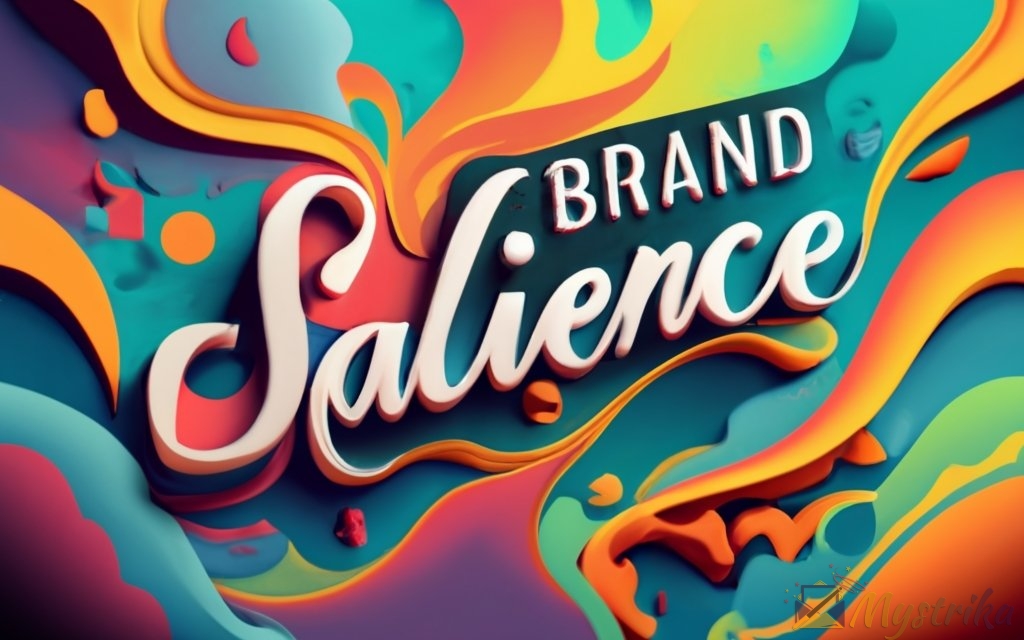Could your brand slip through the cracks during the customer’s purchase decision?
Learn why brand salience is critical for sales – and how to become impossible to ignore.
What is Brand Salience and Why Does it Matter?
Defining Brand Salience
Brand salience refers to how easily and readily your brand comes to mind for customers when they are in a situation where they need to make a purchase decision. It measures how prominent and top-of-mind your brand is for consumers precisely at that critical moment when they are ready to buy.
In other words, brand salience shows how likely your business is to be the first option someone thinks of when they have a specific want or need related to your products or services.
High brand salience means that your brand has strong mental associations in the minds of your target audience. When they enter a buying scenario where your offerings would be relevant, your brand instinctively pops into their mind first before they consider competitors.
For example, Band-Aid bandages have incredibly high brand salience. If you got a small cut, you’d likely reach for a Band-Aid without hesitation or considering other options. The brand is strongly linked to the product category in your mind.
On the other hand, low brand salience means that consumers either don’t know about your brand at all, or don’t have strong enough awareness and familiarity to think of your business when they need related products or services. Your brand gets lost in the shuffle.
Let’s say you opened a brand new coffee shop on a busy street. For local residents used to their regular spots, your new shop probably won’t come to mind right away when they want their morning brew. You have low salience as an unknown brand.
At its core, brand salience measures consumer psychology and memory. According to brand strategy experts like Jenni Romaniuk, brand salience represents “a brand’s propensity to be noticed or come to mind in buying situations.”
For your brand to come to mind, customers need both:
- Memory salience – how strong the network of associations around your brand is in the customer’s brain. Do they easily recall your brand?
- Attention salience – your brand’s ability to capture attention when the customer is ready to make a purchase decision. Can you stand out from the noise?
To build high brand salience, your marketing needs to reinforce those memory networks by linking your brand to positive emotions, situations, and branding. And you need eye-catching and distinctive assets to capture attention at the critical moment.
Difference Between Brand Salience and Brand Awareness
While related, brand salience has some key differences from brand awareness that are important to understand.
Brand awareness refers to how visible and recognizable your brand is in general. It focuses on whether your target audience is familiar with your brand, knows what you offer, and can recall your logo, tagline, visual identity, and other brand assets.
You build awareness through all your ongoing marketing, advertising, PR, events, and other touchpoints. The goal is to get your brand known throughout the marketplace.
However, a customer seeing one of your ads or walking by your shop doesn’t necessarily mean they’ll think of you when it’s time to whip out their wallet. This is where brand salience comes in.
While brand awareness can happen at any stage of the marketing funnel, brand salience is laser-focused on that last step – the actual purchase. It ensures your brand is top-of-mind right when the transaction is about to occur.
For example:
- Brand awareness – A consumer sees one of your social media ads and clicks through to your website to learn more. They are now more aware of your company.
- Brand salience – That same consumer is now ready to buy the product advertised. Your brand immediately comes to mind and they purchase from you.
Your ongoing brand awareness building provides the foundation. Brand salience converts that awareness into sales when it matters most. They work together, but salience is focused on purchase intent.
To summarize:
- Brand awareness – Overall visibility, recognition, and familiarity with your brand.
- Brand salience – Prominence in the consumer’s mind specifically during the purchase moment.
The Importance of Having High Brand Salience
What does high brand salience actually do for your business? Why does it matter whether your brand is top-of-mind or not?
There are several key reasons why brand salience is a crucial asset:
It drives sales directly at the point of purchase
The higher your brand salience, the more likely consumers will think of your company first and buy from you. Brands with the highest salience in their category often capture 50%+ of market share.
When your brand springs to mind for customers, you have a huge edge over competitors. Brand salience provides a mental shortcut that makes the buying decision easy.
Think about ordering pizza. For most people, Domino’s, Pizza Hut, or Papa John’s will instantly come to mind thanks to their strong salience. They don’t have to wade through options.
It attracts and retains loyal customers
Brand salience builds loyalty. According to Wired, brands with high emotional sentiment have been shown to have 3-10x better performance. Salient brands forge those emotional connections.
When you have high salience, you become embedded in the customer’s mindset and usual routines. Purchasing from you becomes instinctive and feels natural.
For example, iPhone users are unlikely to ever consider switching to Android because Apple has such high salience. Their products are deeply linked to customers’ lifestyles.
Investors value brand salience highly
Your brand is one of the most valuable assets a company can have. Strong brand salience makes your business much more attractive to potential investors and adds monetary value.
Investors want to see that your brand has successfully carved out a prominent place in the minds of consumers. That top-of-mind presence signals market dominance and competitive advantage.
For example, Coca-Cola’s brand value increased from $56 billion in 2011 to $91 billion in 2022 largely driven by its unmatched brand salience across generations. Investors covet those intangible assets.
In summary, brand salience ensures consumers think of your brand first at the moment they want to make a purchase. It’s a key driver of sales and loyalty. Building high salience should be a priority for any marketing strategy.
Brand Salience Marketing
To build strong brand salience, your overall branding and marketing strategy needs to focus on capturing attention and creating positive associations in the minds of customers.
There are three key factors your campaigns should aim to deliver:
Distinctiveness: Your brand assets and identity need to help you stand out from competitors. Using your brand colors, logo, tone of voice, taglines consistently builds recognition.
Relevance: You need to align your messaging with the wants, needs, and values of your audience. Show them how your brand “gets them” and solves their problems.
Familiarity: Repeatedly exposing customers to your brand through advertising, content, and experiences builds mental awareness. Refresh their memory so you stay top-of-mind.
Rather than direct sales pitches, brand salience marketing aims to build up positive sentiments and memories over time.
For example, insurance company Geico spends millions annually on quirky, humorous ads. They rarely talk about insurance directly. But those ads stick in your mind, so Geico springs to mind when you do need insurance.
Ultimately, you need a mix of brand awareness campaigns and brand salience initiatives. Awareness gets you known, while salience converts that into sales when it matters most. Pair them together for success.

How to Build and Increase Your Brand Salience
Building strong brand salience takes time, consistency, and an intentional strategy. But it’s a crucial investment that pays off in spades by driving sales. Here are the top proven tactics and tips for improving your brand’s salience:
Use Emotional Storytelling and Messaging
At its core, branding is about making emotional connections with your audience. Storytelling is one of the most powerful ways to do that authentically.
By weaving compelling narratives into your ads, content, and campaigns, you create positive associations and memories around your brand. Emotion is the key to being unforgettable.
For example, Always’ “Like a Girl” campaign told the moving story of the harm caused by using the phrase “like a girl” as an insult. It sparked a viral conversation and cemented Always as a brand that empowers women.
Stories allow you to embed your brand deeply into the lifestyles, relationships, and emotions of your customers. Use messaging and content that tugs at their heartstrings or speaks to shared experiences.
Create Bold, Authentic Branding That Stands Out
In a crowded marketplace, blending in with competitors is a brand salience death sentence. You need to find ways to set yourself apart.
Be bold and take smart risks with your branding and advertising. Try innovative tactics and campaigns your audience won’t expect. Surprise them and make them stop and pay attention.
However, it’s crucial that any bold moves feel authentic and on-brand for you. Contrived efforts that aren’t aligned with your values will fall flat or backfire. Lean into what makes you unique.
For example, the fast food chain Wendy’s boosted brand salience with their infamous Twitter roast battles. The snarky jokes matched their fun, youthful brand personality perfectly while getting attention.
Expand Your Reach to Gain New Potential Customers
It’s tempting to only market to your core audience. But expanding your horizons is vital for improving brand salience over time.
You need to continually find new channels, partnerships, and strategies to expose different demographics to your brand. Getting in front of new eyeballs helps strengthen and broaden your salience.
For example, Coca-Cola partnered with popular TV shows like American Idol to reach younger generations who consume media differently. They adapted to find new potential fans.
Maintain Consistent Branding Across Channels
While reaching new audiences is important, you also need to reinforce your brand identity with existing customers. Consistency and repetition are key to staying top-of-mind.
Use the same visual assets, messaging, tone, and themes across all touchpoints – your website, ads, social posts, email campaigns, and more. Every exposure to your brand should feel familiar.
McDonald’s golden arches, red background, and black lettering have become instantly recognizable around the world thanks to visual consistency. You need those throughlines.
Take Smart Risks and Innovate to Capture Attention
As mentioned earlier, calculated risks help your campaigns cut through the noise and get noticed by customers. Don’t be afraid to try edgy, outside-the-box ideas.
Burger King allowed customers to order using emoji on Twitter. Dove created self-esteem-themed billboards with damaged sections that passersby could interact with and “repair”.
These innovative concepts feel fresh and capture consumer attention while aligning with brand values. Keep innovating within your marketing.
Leverage Influencers to Boost Credibility and Consideration
Partnering with relevant influencers and thought leaders is a smart brand salience strategy. Their endorsement automatically lends you credibility.
For example, when Kylie Jenner promoted SugarBearHair vitamins on Instagram, the unknown brand saw sales leap from $300,000 to over $40 million almost overnight thanks to her influence.
Look for influencers whose audience and interests align closely with your brand. Ensure their promotion feels authentic, not forced. The halo effect from their salience boosts yours.
Provide Exceptional Customer Experiences
While advertising builds awareness, customer experience cements your place in the minds of buyers. Positive, memorable interactions are sales gold.
Deliver stand-out service across all touchpoints, from your welcome emails to your refund policies and everything in between. Exceed expectations whenever you can.
Charm Bomb turned customers into loyal brand advocates with handwritten thank you notes and free products after purchases. Do the little things that wow.
Here are some additional tips for improving brand salience with your marketing:
- Refresh brand assets – Give your website, branding, ads, etc. a facelift. New sites and campaigns attract renewed attention from customers.
- Show behind-the-scenes – Pull back the curtain to showcase your team, culture, and values. Inside looks build affinity and familiarity.
- Reward loyal customers – Surprise and delight program members with perks and benefits. Strengthen their dedication to choosing you first.
- Localize messaging – Adapt some branding elements and assets for different regions you serve to increase relevance.
- Optimize SEM and SEO – Boost brand visibility in search results so customers immediately see you as an option.
- Review metrics often – Keep a close eye on brand surveys, polling, and sales data to identify salience gaps.
The key is to employ both brand awareness and brand salience strategies in harmony. Awareness gets your brand known, salience converts that into loyal buyers ready to purchase from you first. Invest in both over the long-term for maximum impact.

Measuring Your Brand Salience Through Surveys and Focus Groups
Brand salience deals with consumer psychology, so direct qualitative feedback is the best way to measure it. Surveys and focus groups provide the insights you need.
Asking Direct Questions in Surveys
Well-crafted surveys are invaluable for assessing your current brand salience and tracking it over time. You can ask targeted questions to quantify where your brand stands in the minds of customers.
Start by asking directly how likely they are to think of and purchase from your brand compared to alternatives when they’re in the market for your offerings.
- On a scale of 1-10, how likely are you to consider [Brand] first when you want to [buy product/service]?
- How often does [Brand] come to mind immediately when you want to [buy product/service]?
- How frequently do you purchase from [Brand] vs. other competitors when you [buy product/service]?
These types of direct brand salience questions reveal both category ownership and share of mind. They identify how prominent your brand’s place is in the decision journey.
Also use open-ended questions to uncover deeper context behind the numbers:
- What makes you more likely to consider [Brand] first when [buying]?
- When you want to [buy product/service], what other brands come to mind?
- What would make you think of [Brand] more often when [buying]?
The qualitative feedback helps you grasp the emotional connections and associations driving your brand’s salience. Look for themes you can strengthen.
Using Brand Asset Association in Surveys
In your surveys, include exercises that test how strongly customers associate your unique brand assets with your products and identity.
Present respondents with your logo, brand colors, slogans, mascots, fonts, and other visual identity elements. Ask them to describe what brand comes to mind for each.
You can also show imagery of people using your product category. Have respondents name the brand they most associate with that usage situation.
High brand salience means your assets consistently trigger recall of your brand. If other brands or no brands come to mind, you need stronger branding.
Finally, compare your brand asset responses to similar exercises using your competitors. Gauge whether your salience is better, on par with, or lagging behind rivals.
Conducting Focus Groups for Deeper Insights
While surveys provide quantitative data, focus groups offer more detailed qualitative feedback from a smaller group. The interactive nature uncovers deeper insights.
Begin by repeating some of the brand salience questions you might use in a survey such as likelihood to consider your brand first and what triggers that.
Then encourage participants to elaborate on their responses. Keep probing with follow-up questions to learn more:
- What emotions do you feel when you encounter [Brand]? Are they generally positive or negative?
- How does buying from [Brand] make you feel about yourself? Does it align with your self-image?
- How memorable are our latest ad campaigns or brand messages? What sticks out?
- How would you describe our brand personality? Does it resonate with you?
You can also conduct exercises similar to brand asset association surveys. Show focus group participants, your brand assets and slogans and have them describe the brand personality and values they infer.
This helps you determine if your desired brand image is being projected accurately. Misalignments point out branding pain points.
Comparing Results to Your Competitors
The true test of your brand salience is how it stacks up against key competitors. This holds true for both surveys and focus groups.
Ask questions that directly compare your brand vs. rival brands. How likely are they to think of each company first? Which brand is most memorable in advertising? Who offers the best customer experience?
When showing brand assets like logos, include competitors. See if they are equally or more strongly linked to purchase triggers and usage situations for your product category.
Focus groups allow you to go a level deeper to uncover why a competing brand may have higher salience. Identify their differentiators and where your brand falls short. Then improve accordingly.
Regularly evaluating your brand salience against the competition gives you an accurate snapshot of where you stand. It helps you continuously adapt your branding strategy to achieve salience leadership in your niche.
The key is asking the right questions to customers and collecting feedback across both surveys and focus groups. This qualitative data guides all your brand awareness and salience-building initiatives to maximize impact over time.
Do any of these survey and focus group strategies and examples provide fresh inspiration on how you might better measure and track brand salience moving forward?

Tips and Strategies for Improving Brand Salience
Let’s recap some of the most effective tactics and best practices for boosting your brand’s salience based on all we’ve covered:
Establish Emotional Connections Through Storytelling
Logical facts and product features have their place, but stories are what build brand affinity. Use narratives that tap into common experiences, relationships, and emotions your audience can relate to.
For example, Google’s tear-jerking India reunion ad didn’t mention Google products at all. But it linked Google’s brand to cherished family connections.
Weave compelling storytelling throughout your ads, content marketing, and campaigns. Show how your product can enrich people’s lives in meaningful ways.
Ensure Your Brand is Distinctive, Relevant, and Familiar
These are the three brand traits you need to infuse across all touchpoints according to lessons from Byron Sharp.
Distinctive brand identity makes you memorable. Relevance means showcasing how you uniquely meet customer needs better than competitors. And familiarity comes from repetitive exposure to refresh your place in minds.
Audit your current branding and marketing with these three principles in mind. Identify gaps where you may not be distinguishable, connecting with audiences emotionally, or top-of-mind. Improve accordingly.
Refresh Brand Memory Structures with Ongoing Marketing
Brand salience lives in the minds of customers. You need continual marketing across a variety of channels to keep your memory structures topped up.
Use both broad outreach like TV ads and one-to-one email outreach. Strike a balance between brand awareness campaigns and more tactical, promo-based initiatives.
The key is having enough touchpoints and interactions where people are consistently seeing, hearing about, or engaging with your brand. Refreshing brand memories takes repetition.
Capture Attention with Unique and Surprising Content
While you want consistent branding, your content and campaigns also need moments of freshness and novelty that capture attention.
Think about how you can put a new spin on your messaging or offer something truly unexpected that makes audiences pause. Guide them to process your brand more consciously.
For example, Wendy’s broke through the fast food branding blur by using sassy, comedic social media roasting of competitors. It complemented their consistent brand identity with an innovative tactic.
Track Performance and Make Data-Driven Adjustments
You can’t improve what you don’t measure. Make brand salience surveys and polls a consistent part of your marketing analytics.
Look for upward or downward trends in metrics like brand consideration at the point of purchase. Review how your brand assets and touchpoints are performing.
If certain surveys or campaigns cause a spike or drop, analyze what specifically worked or didn’t. Let data guide your marketing optimization.
Here are some other smart brand salience tips:
- Partner with influencers whose credibility can rub off on your brand in the minds of their engaged followers.
- Localize branding elements like imagery and language to boost relevance in different markets you serve.
- Reward loyal customers with surprises and perks to strengthen brand attachment emotional bonds.
- Monitor reviews and testimonials for brand sentiment themes you can amplify in messaging.
- Keep innovating with bold campaigns that capture interest and remind customers your brand is fresh.
The overarching strategies remain: Forge emotional connections, stay distinctive and relevant, and be relentless about putting your brand in front of your audience. Consistent creativity and optimization will build lasting salience.

Why Brand Salience is Critical to Business Success
Building strong brand salience provides several tangible business benefits that directly impact your bottom line and attract investors.
Brand Salience Drives Sales at the Point of Purchase
The #1 reason salience matters is it leads directly to sales. Study after study shows that brands with top salience in their category capture the lion’s share of purchases.
According to Nielsen, the top 100 brands globally with high salience account for over 30% of CPG sales. Despite the vast number of choices, a handful of top-of-mind brands dominate.
When your brand is the first one in the consumer’s consideration set at the moment they want to buy, you have a huge competitive advantage. Salience provides a mental shortcut right to selecting your product.
For example, no one sifts through tissue options at the store. They grab Kleenex immediately because that brand is deeply ingrained as the default choice when you need tissues.
High salience means you win the majority of purchases within your niche without customers considering or worrying about alternatives. It’s an invaluable asset.
High Brand Salience Attracts and Retains Loyal Customers
Salient brands don’t just earn purchases in the moment. They foster true loyalty where customers stick around for life.
Research shows emotionally-attached customers have 3-10x better lifetime value thanks to repeat purchases, referrals, and higher spend. Brand salience drives that emotional connection.
When your brand occupies a prominent place in the customer’s mind, choosing you becomes habitual. It feels like second nature and the natural option aligned with their lifestyle and identity.
This loyalty provides predictable recurring revenue. Once your brand is ingrained as part of someone’s routine, it’s hard to displace you. Customers become brand advocates.
Investors View Brand Salience as an Asset and Advantage
Your brand itself is one of the most valuable assets a company has. When considering investment opportunities, brand salience is a major factor for investors.
Strong salience signals market dominance and competitive edge to investors. It shows your brand has carved out a winning position in the minds of consumers.
High salience also hints at barriers to entry against competitors and Matthews Mill Brand’s Is Product Market Fit a New Brand Strategy? against disruption. Your brand feels like the default choice – something newcomers will struggle to overcome.
Investors view leading brand salience as monetary value. Brand Finance determined the average brand value boost across industries is 23% for brands with strong brand salience.
For all these reasons, brand salience should be central to your marketing strategy. It compoundingly improves almost every aspect of business success from sales to loyalty to company valuation.
Make brand salience tracking and improvement a constant process. The payoff of sustaining top-of-mind presence in your niche is transformative.
Key Takeaways on Improving Brand Salience
- Brand salience refers to how easily your brand comes to mind when customers are making purchase decisions. High salience means you are top-of-mind.
- Salience focuses on the final purchase moment, whereas brand awareness relates to overall visibility. Both are important.
- High brand salience provides a competitive edge by driving sales, loyalty, word-of-mouth, and investor appeal.
- Build salience by using emotional storytelling in your marketing, refreshing brand memories consistently, and capturing attention with innovation.
- Measure brand salience through surveys and focus groups that provide qualitative data about brand perceptions and associations.
- Key drivers of salience are distinctiveness, relevance, familiarity, innovativeness, customer experience, and consistency.
- Regularly compare your brand’s salience against competitors to identify gaps and opportunities for improvement.
- Make boosting your brand salience a priority, and track progress over time. The payoff in sales and loyalty is immense.
Focusing on brand salience ensures your marketing directly converts into sales at the moments that matter most. Keep these tips in mind, and you’ll be on your way to becoming a top-of-mind brand in your niche.
Frequently Asked Questions About Brand Salience
Let’s wrap up by answering some of the most common questions people have around building and measuring brand salience.
What is an example of high brand salience?
Some standout examples of brands with very high salience in their respective categories include:
- Kleenex – Tissues
- Coca-Cola – Soda
- Band-Aid – Adhesive bandages
- Google – Search engine
- Amazon – Online retail marketplace
- Uber – Ridesharing services
- Netflix – Video streaming
What these brands have in common is that they are most likely to immediately come to mind for consumers when needing that product or service.
Kleenex has reached brand name status synonymous with tissues. People instinctively buy Coca-Cola when thirsty rather than debating soda options. Band-Aid is such a salient brand that people call any small adhesive bandage a Band-Aid.
These brands have forged strong mental connections over decades of marketing focused on consistency, repetition, emotion, and distinctive assets. They are truly top-of-mind in their markets.
How can brand salience be measured quantitatively?
While mostly conceptual, here are a few quantitative metrics that can gauge brand salience:
- Category purchase intent – What % of surveyed consumers say they would consider your brand first for a given purchase need?
- Aided awareness – When shown your brand assets, what % associate them correctly with your brand?
- Brand asset linkage – How strongly do users link visual brand elements like your logo to your products and their benefits?
- Share of voice – What % of social conversations, search interest, and online mentions focus on your brand vs. competitors?
- Merchandising audits – What share of in-store displays, product placement, and shelf space is captured by your brand in retail locations?
Combining qualitative brand salience survey and focus group data with these types of quantitative metrics provides a more complete picture. You can identify gaps between brand perception and real-world presence.
What are the key drivers of brand salience?
The main factors that contribute to high brand salience include:
- Distinctive identity – Logo, colors, fonts, imagery that uniquely represent your brand
- Consistent exposure – Repetitive touchpoints and marketing refresh brand memories
- Emotional storytelling – Messaging and ads that create meaningful connections
- Relevant branding – Aligning brand image and personality with your core audience
- Innovation – Novel, attention-grabbing campaigns and content
- Customer experience – Positive interactions and problem-solving that build loyalty
Get these brand salience drivers right in your overall strategy, and your place in the minds of customers will continue to grow.
How does brand salience differ from brand awareness?
Brand awareness focuses on your general visibility and recognition in the marketplace across the whole customer journey. Brand salience is specifically your prominence at the very bottom of the funnel when a purchasing decision is being made.
For example, brand awareness includes metrics like:
- Unaided awareness – Can people name your brand when prompted about a category?
- Social reach – How many people are exposed to your brand on social media?
- Website visitors – How much traffic comes to your branded web presence?
Brand salience looks at:
- Purchase consideration – How likely are prospects to consider your brand first when ready to buy?
- Category associations – How strongly are your brand assets linked to a product category need?
- Decision journey prominence – Where does your brand rank in the choice process for shoppers?
So brand awareness drives overall recognition, while salience converts that into sales when it matters most. They work hand in hand, with salience focused on the final transaction.
Why is brand salience important for marketing?
For marketing teams, brand salience should be a top priority KPI because it:
- Drives revenue – High salience means you convert more sales with less effort at the point of purchase.
- Builds loyalty – Salient brands become intrinsic to customers’ lifestyles and identity. This loyalty powers growth.
- Maximizes marketing ROI – When you are top-of-mind, you get the most bang for your marketing buck and outcompete.
- Fuels word-of-mouth – Customers are more likely to recommend and vouch for brands that readily come to mind.
- Attracts investors – Strong salience makes your brand itself an attractive asset and signals market edge.
- Enhances overall awareness – Salience gives your general branding and awareness campaigns more conversion potential.
Simply put, high brand salience is a competitive advantage that makes your marketing work harder and fuels business success. It should be central to any brand strategy.
Hopefully these examples provide more context on brand salience and equip you to improve it for your business.

